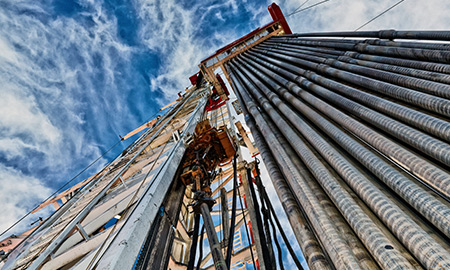US Shale Fracklog Triples As Drillers Keep Oil From Market

(Bloomberg) -- Think the U.S. is awash in crude now? Thank the fracklog that it’s not worse.
Drillers in oil and gas fields from Texas to Pennsylvania have yet to turn on the spigots at 4,731 wells they’ve drilled, keeping 322,000 barrels a day underground, a Bloomberg Intelligence analysis shows. That’s almost as much as OPEC member Libya has been pumping this year.
The number of wells waiting to be hydraulically fractured, known as the fracklog, has tripled in the past year as companies delay work in order to avoid pumping more oil while prices are low. It’s kept crude off the market with storage tanks the fullest since 1930. The fracklog may slow a recovery as firms quickly finish wells at the first sign of higher prices.
“Once service costs come down and drillers begin to work through their higher-than-normal backlog, the market should start to price in that supply coming online,” Andrew Cosgrove, an energy analyst for Bloomberg Intelligence in Princeton, New Jersey, said by phone. “It may act as a cap on prices.”
Futures for U.S. benchmark West Texas Intermediate oil tumbled by more than $50 a barrel in second half of last year amid a worldwide glut of crude. They rose $1.58 to settle at $57.74 a barrel on the New York Mercantile Exchange.
Growing Fracklog
Oil production in the lower 48 states would rise 322,000 barrels a day to an average 7.485 million in the fourth quarter of 2016 if drillers start shrinking their fracklogs by 125 wells a month in October, Bloomberg Intelligence models show. The forecast assumes horizontal oil rigs fall another 10 percent through the third quarter and prices are unchanged.
A second scenario, in which crude prices rebound to $60 to $65 a barrel for an extended period and drillers put rigs back to work, increases supply by 500,000 barrels a day to 7.67 million.
The U.S. fracklog has ballooned as drillers wait for prices to recover, with oil wells making up more than 80 percent of the total.
The Permian Basin, which covers parts of Texas and New Mexico, had the biggest collection of unfracked wells as of February, with 1,540 waiting to be completed. The count totaled 1,250 in Texas’s Eagle Ford formation and 632 in North Dakota’s Bakken shale.
Last week, Raoul LeBlanc, an oil analyst with Englewood, Colorado-based consultant IHS Inc., pegged the U.S. fracklog at around 3,000 wells. Halliburton Co., the world’s second-biggest provider of oilfield services, estimated there are about 4,000 uncompleted wells, citing “third party estimates.”
Fringe Counties
Fracklogs are growing faster in the fringe areas of play relative to the cores where the most productive wells are, according to the Bloomberg Intelligence analysis. In the Eagle Ford, for example, counties at the edge of the play like Lee and Lavaca saw companies go from completing more than 60 percent of their wells in November to less than 20 percent in February.
Large independent producers such as ConocoPhillips, Occidental Petroleum Corp., Marathon Oil Corp., Hess Corp. and EOG Resources Inc. hold a significant portion of the backlog of drilled but uncompleted wells.
Those companies are already seeing more incentive to start eating into their backlog as crude prices have risen by a third since mid-March. After-tax returns would be 5 percent to 10 percent higher than they were just two months ago when oil was at $45, Cosgrove said.
ConocoPhillips Chief Executive Officer Ryan Lance said at the IHS CERAWeek Energy conference in Houston on Monday that increased well completions may exacerbate the supply glut, depending on whether oil demand rises.
“Those who are drilling and deferring completions -- obviously if they get a price signal that the commodity price is coming back a little bit you’ll see more supply come on,” he said.
With assistance from David Wethe in Houston.
To contact the reporters on this story: Lynn Doan in San Francisco at ldoan6@bloomberg.net; Dan Murtaugh in Houston at dmurtaugh@bloomberg.net To contact the editors responsible for this story: David Marino at dmarino4@bloomberg.net Stephen Cunningham
WHAT DO YOU THINK?
Generated by readers, the comments included herein do not reflect the views and opinions of Rigzone. All comments are subject to editorial review. Off-topic, inappropriate or insulting comments will be removed.
- How Likely Is an All-Out War in the Middle East Involving the USA?
- Rooftop Solar Now 4th Largest Source of Electricity in Australia
- US Confirms Reimposition of Oil Sanctions against Venezuela
- EU, Industry Players Ink Charter to Meet Solar Energy Targets
- Analyst Says USA Influence on Middle East Seems to be Fading
- Russian Ships to Remain Banned from US Ports
- Brazil Court Reinstates Petrobras Chair to Divided Board
- EIB Lends $425.7 Million for Thuringia's Grid Upgrades
- Var Energi Confirms Oil Discovery in Ringhorne
- Seatrium, Shell Strengthen Floating Production Systems Collaboration
- An Already Bad Situation in the Red Sea Just Got Worse
- What's Next for Oil? Analysts Weigh In After Iran's Attack
- USA Regional Banks Dramatically Step Up Loans to Oil and Gas
- EIA Raises WTI Oil Price Forecasts
- How Likely Is an All-Out War in the Middle East Involving the USA?
- Venezuela Authorities Arrest Two Senior Energy Officials
- Namibia Expects FID on Potential Major Oil Discovery by Yearend
- Oil Markets Were Already Positioned for Iran Attack
- Is The Iran Nuclear Deal Revival Project Dead?
- Petrobras Chairman Suspended
- Oil and Gas Executives Predict WTI Oil Price
- An Already Bad Situation in the Red Sea Just Got Worse
- New China Climate Chief Says Fossil Fuels Must Keep a Role
- Oil and Gas Execs Reveal Where They See Henry Hub Price Heading
- Equinor Makes Discovery in North Sea
- Macquarie Strategists Warn of Large Oil Price Correction
- DOI Announces Proposal for Second GOM Offshore Wind Auction
- Standard Chartered Reiterates $94 Brent Call
- Chevron, Hess Confident Embattled Merger Will Close Mid-2024
- Analysts Flag 'Remarkable Feature' of 2024 Oil Price Rally






